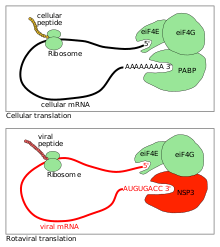NSP3 (rotavirus)
| Non Structural Rotavirus Protein 3 | |
|---|---|
| Identifiers | |
| Symbol | NSP3 |
| PDB | 1LJ2 |

Rotavirus protein NSP3 (NS34) is bound to the 3' end consensus sequence of viral mRNAs in infected cells.[1]
Four nucleotides are the minimal requirement for RNA recognition by rotavirus non-structural protein NSP3: using short oligoribonucleotides, it was established that the minimal RNA sequence required for binding of NSP3A is GACC.[2]
Rotavirus RNA-binding protein NSP3 interacts with eIF4GI and evicts the poly(A)-binding protein from eIF4F. And NSP3A, by taking the place of PABP on eIF4GI, is responsible for the shut-off of cellular protein synthesis.[3]
Expression of NSP3 in mammalian cells allows the efficient translation of virus-like mRNA: NSP3 forms a link between viral mRNA and the cellular translation machinery and hence is a functional analogue of cellular poly(A)-binding protein.[4]
Site-directed mutagenesis and isothermal titration calorimetry documented that NSP3 and PABP use analogous eIF4G recognition strategies, despite marked differences in tertiary structure.[5]
Using the yeast two-hybrid assay, RoXan a novel cellular protein was found to bind NSP3. The interaction between NSP3 and RoXaN does not impair the interaction between NSP3 and eIF4GI, and a ternary complex made of NSP3, RoXaN, and eIF4G I can be detected in rotavirus-infected cells, implicating RoXaN in translation regulation.[6]
References
- ↑ Poncet D, Aponte C, Cohen J (June 1993). "Rotavirus protein NSP3 (NS34) is bound to the 3' end consensus sequence of viral mRNAs in infected cells" (Free full text). Journal of Virology. 67 (6): 3159–65. PMC 237654. PMID 8388495.
- ↑ Poncet D, Laurent S, Cohen J (September 1994). "Four nucleotides are the minimal requirement for RNA recognition by rotavirus non-structural protein NSP3" (Free full text). The EMBO Journal. 13 (17): 4165–73. PMC 395339. PMID 8076612.
- ↑ Piron M, Vende P, Cohen J, Poncet D (October 1998). "Rotavirus RNA-binding protein NSP3 interacts with eIF4GI and evicts the poly(A) binding protein from eIF4F" (Free full text). The EMBO Journal. 17 (19): 5811–21. doi:10.1093/emboj/17.19.5811. PMC 1170909. PMID 9755181.
- ↑ Vende P, Piron M, Castagné N, Poncet D (August 2000). "Efficient translation of rotavirus mRNA requires simultaneous interaction of NSP3 with the eukaryotic translation initiation factor eIF4G and the mRNA 3' end" (Free full text). Journal of Virology. 74 (15): 7064–71. doi:10.1128/JVI.74.15.7064-7071.2000. PMC 112224. PMID 10888646.
- ↑ Groft CM, Burley SK (June 2002). "Recognition of eIF4G by rotavirus NSP3 reveals a basis for mRNA circularization". Molecular Cell. 9 (6): 1273–83. doi:10.1016/S1097-2765(02)00555-5. PMID 12086624.
- ↑ Vitour D, Lindenbaum P, Vende P, Becker MM, Poncet D (April 2004). "RoXaN, a novel cellular protein containing TPR, LD, and zinc finger motifs, forms a ternary complex with eukaryotic initiation factor 4G and rotavirus NSP3" (Free full text). Journal of Virology. 78 (8): 3851–62. doi:10.1128/JVI.78.8.3851-3862.2004. PMC 374268. PMID 15047801.